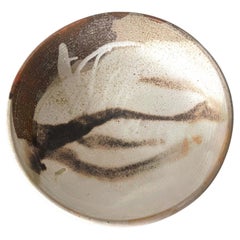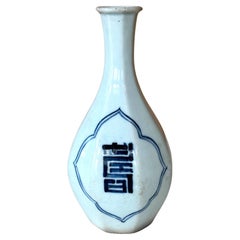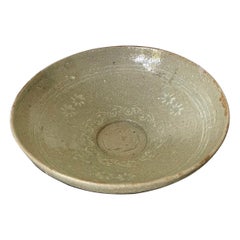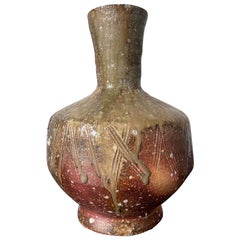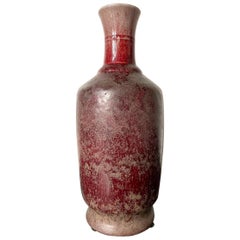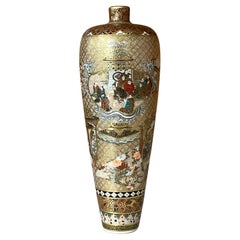Atlanta - Ceramics
to
23
287
1,956
1,351
264
23
41
1
1
114
74
76
23
36
8
16
12
2
1
2
2
2
285
59
11
9
6
261
252
115
76
61
287
287
287
27
11
10
3
3
Item Ships From: Atlanta
Large Ceramic Center Bowl Toshiko Takaezu
By Toshiko Takaezu
Located in Atlanta, GA
A large ceramic center bowl by Japanese American artist Toshiko Takaezu (American, 1922 - 2011). Meant to be a bespoken center piece., the deep form bowl features a robust body of thick wall, supported by a short round foot ring. The surface showcases an expressive glaze pattern that is the signature style to the artist's work. Free-flowing abstract strokes...
Category
Late 20th Century American Modern Atlanta - Ceramics
Materials
Ceramic
Korean Ceramic Faceted Blue and White Bottle Vase Joseon Dynasty
Located in Atlanta, GA
A Korean blue and white long neck vase in bottle form with octagonal faceted surface from Joseon Dynasty (19th century). The elegant vase is cove...
Category
19th Century Korean Archaistic Antique Atlanta - Ceramics
Materials
Ceramic
Korean Ceramic Celadon Bowl with Slip Inlay Goryeo Dynasty
Located in Atlanta, GA
Despite inspired originally by the celadons from Song dynasty in China, the development of celadon in Korean peninsula took its own course and reached the zenith in the 11-12th century during Goryeo dynasty...
Category
15th Century and Earlier Antique Atlanta - Ceramics
Materials
Ceramic
Modern Japanese Ceramic Shigaraki Ikebana Vase Takahashi Shunsai
Located in Atlanta, GA
A tall ceramic vase made in the tradition of Shigaraki ware by Japanese potter Takahashi Shunsai (1927-2011), the fourth heir of the famed Rakusai lineage of potters. The vase is heavily potted in the reddish sandy Shigaraki clay. It has a Classic vase form made for Ikebana display. The surface is thickly draped with natural ash glaze that deposited onto the body during the firing process in the kiln. It also features decoration of carved lines. Nuggets of feldspar were incorporated in the clay and exposed onto the surface as crystal like jewels. Substantial and archaic looking, the vase also has a strong modern appeal due to its Mingei styling. It was signed on the base with a pressed seal Shunsai as shown. The vase comes with its original wood storage box (tomobako) with bears the title and signature in Kanji and a seal. It also retains a paperwork noting the artist's biography and practice philosophy in Japanese.
Born in Shigaraki, Shunsai was the second son of renowned potter Takahashi Rakusai...
Category
1990s Japanese Modern Atlanta - Ceramics
Materials
Ceramic
Large Antique Chinese Sang-de-Boeuf LangYao Red Vase
Located in Atlanta, GA
A large Chinese vase with Sang-de-Boeuf (oxblood) glaze in a classic baluster form with a tall narrow neck and horizontal bands around the shoulder. The oxblood glaze is known as Lan...
Category
Late 19th Century Chinese Chinese Export Antique Atlanta - Ceramics
Materials
Ceramic
Exquisite Japanese Satsuma Vase by Seikozan
Located in Atlanta, GA
A miniature vase in elegant upright form reminiscent of the Chinese imperial Willow Leaf form made by Japanese studio Seikozan circa 1890-1910s (late Meiji Period). One of the many a...
Category
1880s Japanese Meiji Antique Atlanta - Ceramics
Materials
Ceramic
Korean Glazed Ceramic Vase Buncheong Ware Joseon Dynasty
Located in Atlanta, GA
A small antique Korean Buncheong stoneware vase from early Joseon Dynasty circa 16th century. The vase is of a classic pear form with a waisted neck, a flared mouth and a ringed base...
Category
16th Century Korean Other Antique Atlanta - Ceramics
Materials
Ceramic
Pair of Small Korean Celadon Inlay Vases Goryeo Dynasty
Located in Atlanta, GA
On offer is a near pair antique Korean ceramic vase from the end of Goryeo to the beginning of Joseon period (circa 14-15th). The vases feature cel...
Category
15th Century and Earlier Korean Archaistic Antique Atlanta - Ceramics
Materials
Ceramic
Japanese Celadon Lidded Vessel Mizusashi by Uichi Shimizu
Located in Atlanta, GA
A ceramic lidded celadon vessel made by Japanese potter Uichi Shimizu (1926-2004) circa post 1980s. The vessel was known as Mizusashi in Japanese and used as a freshwater container t...
Category
Late 20th Century Japanese Modern Atlanta - Ceramics
Materials
Ceramic
Contemporary Ceramic Sculpture Deconstructed Vase by Steven Young Lee
Located in Atlanta, GA
A bespoken ceramic sculpture made by American Korean artist Steven Young Lee (1975-) circa 2010s. Inspired by the antique blue and white porcelain jar from Joseon Dynasty, the piece ...
Category
2010s American Post-Modern Atlanta - Ceramics
Materials
Ceramic
Japanese Contemporary Celadon Ceramic Bowl by Ono Kotaro
By Ono Kotaro
Located in Atlanta, GA
A ceramic bowl with celadon glaze by Japanese potter Ono Kotaro (Japanese, b. 1953). Named "Circular Reef", the fine porcelain bowl features an irregular ed...
Category
Late 20th Century Japanese Modern Atlanta - Ceramics
Materials
Ceramic
Korean Ceramic White Porcelain Water Dropper Joseon Dynasty
Located in Atlanta, GA
A small Korean water dropper in rectangular form with beveled edges, circa early 19th century of the Joseon Dynasty. The milky white porcelain pie...
Category
19th Century Korean Other Antique Atlanta - Ceramics
Materials
Ceramic
Japanese Ceramic Vase Mingei Style Hamada Shoji
By Hamada Shoji
Located in Atlanta, GA
A heavily potted stoneware vase in cylindrical form, decorated with abstract strokes in iron rust glaze (known as Persimmon Glaze in Japanese) on a black glazed background. The pattern suggests autumn grasses, and it was applied with free hands. The vase is attributed to Japanese potter Hamada Shoji...
Category
Late 20th Century Japanese Arts and Crafts Atlanta - Ceramics
Materials
Ceramic
Antique Korean Ceramic White Bowl Joseon Dynasty
Located in Atlanta, GA
A Korean ceramic rice bowl covered in a white glaze with a hint of bluish green color circa 19th century toward the end of Joseon Dynasty. The deep bowl...
Category
19th Century Korean Other Antique Atlanta - Ceramics
Materials
Ceramic
Japanese Glazed Ceramic and Silver Koro Incense Burner Makuzu Kozan
By Makuzu Kozan
Located in Atlanta, GA
A tri-pod ceramic incense burner (koro) by Japanese Imperial potter Makuzu Kozan (1842-1916) circa late Meiji to the start of Taisho period (1890-1910s). A fine example of the artist's work belonging to the late part of his underglaze paint phase (started around 1887 until his death), the surface of the koro was painted in beautiful shades of blue to depict a continuous landscape not unlike a traditional ink and watercolor hand scroll. The rise and fall mountains recede and fade into the horizon and are dotted with groves of pines. The sky is painted with a beautiful subtle shade of pink, suggesting a time of sunrise or sunset. The koro is fitted with an ensuite reticulated sterling silver hoya (incense cover), pierced with swirling cloud and marked with "pure silver' in Kanji. The base is signed in underglaze blue "Makuzu Kozan Sei" within a double ring. The piece is beautifully potted in form and the decoration was done with expertise using the novel technique developed by Kozan called Fuki-e (the blow painting), in order to achieve the striking landscape known as "Mountain and Water" with sense of dimensions and gradient, the poetic effects normally conveyed only by sumi ink staining on paper. The piece comes with an unsigned tomobako (wood storage box) of a recent age.
Also known as Miyagawa Kozan (1842–1916), Makuzu Kozan was one of the most established and collected ceramist from Meiji Period. Born as Miyagawa Toranosuke, Kozan established his pottery studio in Yokohama around 1870s and later became one of the appointed artists to the Japanese Imperial household. His work was exhibited in many international fairs that the Meiji government participated at the turn of the century and won many grand prizes. Being one of the most creative ceramists, Kozan started experimenting with new chemical colors from the West in the format of his porcelain glaze around 1880s. New colors allowed him to create underglaze designs that appeared bright, smooth and glossy. He even invented his own receipt of cobalt blue to achieve a much brighter yet softer shade, as evident on this vase. To create landscape that is realistic and dimensional, more common in the western paintings, he was inspired by the native Japanese ink painting technique developed around 1900 by Yokoyama...
Category
Early 1900s Japanese Japonisme Antique Atlanta - Ceramics
Materials
Silver
Round Porcelain Box from the Hatcher Collection Decorated with Phoenix
Located in Atlanta, GA
17th century Chinese porcelain blue and white cosmetics box from the Hatcher Collection decorated with a phoenix. The phoenix is painted with its wings outstretched, its tail flutter...
Category
17th Century Chinese Antique Atlanta - Ceramics
Materials
Porcelain
Japanese Studio Ceramic Vase by Ken Matsuzaki with Original Tomobako
By Ken Matsuzaki
Located in Atlanta, GA
An impressive stoneware bottle form vase by contemporary Japanese studio potter Ken Matsuzaki (1950-) circa 2010s. The solid form takes its cue from Chinese traditional plum vase (Meiping) with raised and swelled shoulder and a small opening, yet it rises from a non-conventional pentagonal faceted base. The extraordinary surface was covered with Yohen Shino glaze in a deep iron hue. Thick white slips were applied in bold strokes to the lower portion of the vase. The abstract pattern calls to mind of the imagery of the iconic ocean waves found in traditional Japanese art. The presence of the vase is strong and none-compromising, reaching back to the past yet appearing utterly modern. It is marked by the artist underneath and comes with the original tomobako with title and author inscriptions and a wrapping cloth with the artist's seal.
"Ken Matsuzaki’s haptic ceramics bring a contemporary approach to traditional Japanese ceramicware, most notably 16th-century Oribe pottery...
Category
21st Century and Contemporary Japanese Modern Atlanta - Ceramics
Materials
Ceramic
Antique Korean Ceramic White Bowl Joseon Dynasty
Located in Atlanta, GA
A Korean ceramic porcelain bowl covered in a white glaze with a hint of bluish green circa 18th century, possibly earlier, of the Joseon Dynasty. The deep bowl was hand-thrown on the...
Category
18th Century Korean Archaistic Antique Atlanta - Ceramics
Materials
Ceramic
Antique Islamic Ceramic Glazed Bowl with Splashed and Sgraffito Decoration
Located in Atlanta, GA
A small Islamic ceramic bowl circa 11-12th century, possibly from Nishapur or Aghkand area of Persia. The elegantly shaped bowl with a slightly flared opening is supported on a small foot rim. The earth ware...
Category
15th Century and Earlier Persian Islamic Antique Atlanta - Ceramics
Materials
Ceramic
Rare Korean Water Dropper in Doughnut Form Joseon Dynasty
Located in Atlanta, GA
A Korean blue and white porcelain water dropper in a rare hallowed out doughnut shape from Joseon Dynasty circa 1800s. The octagonal water droppe...
Category
Late 18th Century Korean Other Antique Atlanta - Ceramics
Materials
Ceramic
Early Japanese Satsuma Antique Vase
By Satsuma
Located in Atlanta, GA
An Satsuma ceramic stone ware vase, circa 19th century, around the end of the Edo and the beginning of Meiji period. In the form of a Classic garlic bottle whose prototype was from China, the white bodied piece is decorated with an early form of kin nishikide, the so called golden brocade, a palette of iron-red, blue, green, yellow, purple and black with golden highlight. The over glazed enamel paint shows a group of robed figures in a garden setting with a lion and three tigers. A transparent overall glaze shows very fine crackles. The design is relatively sparse with plenty of negative space in contrast to the Satsuma production from the late 19th century, when the trend became fussy and overly glitz, due to the influence by the perceived western taste for the export market. This piece may still be made for export but its pattern was more influenced by both Kyoto Pottery and the Kano school of painting compared to the export ware by the end of the 19th century onward to the early 20th century. It was believed by many that this was a result of Satsuma potters visiting Kyoto in the late seventeenth century to learn over glaze painting techniques.
There are some age glaze crackles especially around the foot. The piece is not signed in keeping with the earlier production before Satsuma ceramics...
Category
Mid-19th Century Japanese Japonisme Antique Atlanta - Ceramics
Materials
Ceramic
$2,850 Sale Price
25% Off
Large Japanese Contemporary Ceramic Jar from Onda Yaki Kiln
By Onda Yaki
Located in Atlanta, GA
A large Japanese lidded ceramic jar from the kiln of Onda Yaki, circa 2010. The stoneware jar impresses the viewer with a robust bulbous form. Its black body is nearly unglazed but exuberantly splashed with strokes of slip glazes of white, yellow and blue. The visual effect is wonderful that it appears traditional and contemporary at the same time. The tri-color glaze calls to mind the San-Cai from Chinese Tang dynasty, yet the application is akin to abstract painting on canvas.
Onda Yaki also spelled as Onta Yaki also spelled Onta, is a type of Japanese pottery produced in and around the village of Onta in Oita Prefecture in Kyushu Island. It was founded in 1705. Closely associated with Mingei folk art, Onda ware was inscribed by the national government in 1995 as an Intangible Cultural Property
Background from Pucker Gallery where the jar was exibited and purchased.
"In his search for true folk pottery, the Japanese philosopher Soetsu Yanagi...
Category
2010s Japanese Organic Modern Atlanta - Ceramics
Materials
Ceramic
Korean white Porcelain Ritual Incense Burner with Bagua Pattern Joseon Dynasty
Located in Atlanta, GA
An antique Korean ritual incense burner circa 19th century, late Joseon dynasty. It was made in Bunwon Kiln in Gwangju, Gyeonggi Do, near Seoul. The ceramic container has a thickly b...
Category
19th Century Korean Archaistic Antique Atlanta - Ceramics
Materials
Ceramic
Small Korean Stoneware Bungcheong Bowl Joseon Dynasty
Located in Atlanta, GA
A small Korean ceramic shallow bowl on ringed foot in the classic Buncheong (or Punch'ong) style from Joseon Dynasty circa 15-16th century. Originally intended for wine-drinking like...
Category
16th Century Korean Archaistic Antique Atlanta - Ceramics
Materials
Ceramic
Korean Celadon Inlay Plate Goryeo Period
Located in Atlanta, GA
The round ceramic plate with a slightly raised foot ring is dated from late Korean Goryeo Kingdom (918 to 1392 AD) likely toward the end of the 14th century. The plate features a celadon glaze and underglaze slip inlays in black and white. The inlays showcases a pair of bird (appears to be cranes) in the center of a radiating double walled ring...
Category
15th Century and Earlier Korean Archaistic Antique Atlanta - Ceramics
Materials
Ceramic
Rare Korean Ceramic Brush Holder Joseon Dynasty
Located in Atlanta, GA
A rare Korean porcelain brush holder in Banana Leaves pattern from late Joseon dynasty circa 19th century. Cherished by the scholars, this brush...
Category
19th Century Korean Other Antique Atlanta - Ceramics
Materials
Ceramic
Japanese Ceramic Vase with Delicate Carvings by Makuzu Kozan Meiji Period
By Makuzu Kozan
Located in Atlanta, GA
A delicate and rare Japanese ceramic vase by the important Meiji imperial potter Makuzu Kozan (1842-1916) circa 1887-1910. Dated to his underglaze phase post 1887 after he successful...
Category
1890s Japanese Japonisme Antique Atlanta - Ceramics
Materials
Ceramic
Blue-Glazed Porcelain Box from Hatcher Collection
Located in Atlanta, GA
17th century Chinese porcelain blue-glazed circular pill box from the Hatcher Collection, painted in different tones of blue with a central prunus flower on a wave pattern ground tha...
Category
17th Century Chinese Antique Atlanta - Ceramics
Materials
Porcelain
Glazed Ceramic Tea Bowl with Abstract Strokes by Toshiko Takaezu
By Toshiko Takaezu
Located in Atlanta, GA
A glazed ceramic tea bowl (chawan) by Japanese American artist Toshiko Takaezu (American, 1922 - 2011). The well-balanced form is hand built and shows slight irregularity, further ac...
Category
Late 20th Century American Modern Atlanta - Ceramics
Materials
Ceramic
Korean Ceramic Celadon Bowl with Slip Inlay Goryeo Dynasty
Located in Atlanta, GA
The celadon bowl on offer here was likely dated to the 14th century toward the end of Goryeo Dynasty, after the production quality reached its zenith during 11-12th century. The bowl...
Category
15th Century and Earlier Korean Archaistic Antique Atlanta - Ceramics
Materials
Ceramic
Japanese Contemporary Ceramic Sculpture Kiyoharu Ichino
By Kiyoharu Ichino
Located in Atlanta, GA
"Purple Dawn", a ceramic sculpture piece by Japanese potter Kiyoharu Ichino (1957-). Purchased from Touching Stone, Santa Fe, New Mexico in 2003. Tradition meets renovation, this sculptural piece with its slab like minimal shape draws the viewer into its mysterious shape that is reminiscent of a monument. Its surface, with the typical Tanba clay fired at very high temperature and completely free of glaze, radiates a subtle metallic sheen that is nearly in a shade of purple. This piece was purchased from Touching Stone, Santa Fe, New Mexico in 2003.
Artist's bio from the gallery and the exhibition:
"Kiyoharu Ichino was born in 1957 in Tachikui into an extended family steeped in pottery-making tradition. He learned all aspects of Tanba pottery since childhood. When he was twenty, he moved to Seto to study pottery under a master of Akatsu-yaki. Upon returning to Tachikui, he launched his career with the Tanba Group Kiln. In 1983, he established his own kiln and began showing in galleries all over Japan. His works have been selected repeatedly for the prestigious juried Japan Traditional Crafts Exhibition sponsored by the Japan Crafts Association. In 1995, he was nominated to be a permanent member of The Japan Crafts Association, an honor bestowed to the most experienced and talented artists.
Traditional Tanba pottery is fired unglazed at very high temperature in large wood-fueled kilns. Ichino uses both an anagama (hole kiln) and a noborigama (climbing kiln), burning almost a thousand bundles of wood over several days to bring out the unique personalities of Tanba clay, which is renowned for its rich texture and deep purplish brown colors. Many of his pieces show silvery fire-marks like swirling mists left by the wood fire. His pieces appear to be integral parts of the clay rather than separate objects made from it. To show the unique clay texture, he often includes seemingly unfinished edges in his designs, exposing the rough clay body. Despite the high level of sophistication and innovation, Ichino's works maintain a strong connection with the ancient Tanba pottery tradition. Ichino should be no stranger to many Santa Fe residents. His work has been exhibited both in Touching Stone Gallery and as part of a major exhibition in the New Mexico Museum of International Folk Art in 2006.
About Tanba ware...
Category
Early 2000s Japanese Modern Atlanta - Ceramics
Materials
Ceramic
19th Century, Chinese Export Famille Rose Medallion Centerpiece Bowl 15.75"
Located in Atlanta, GA
Chinese, 19th century.
A fine quality antique Chinese famille rose medallion wash basin or centerpiece bowl. The center has a vivid immortal courtyard scene surrounded by a greek key border and 4 matching windows to the interior edge. The border adorned with butterflies, bird and floral motifs all enameled over a celadon base...
Category
19th Century Chinese Chinese Export Antique Atlanta - Ceramics
Materials
Enamel
$2,316 Sale Price
20% Off
Ceramic Bowl Buncheong Ware Joseon Dynasty
Located in Atlanta, GA
A Buncheong (also spelled as Punch'ong) stoneware tea bowl from Korea Joseon Dynasty circa 15-16th century. The conical shape bowl in the classical styl...
Category
16th Century Korean Archaistic Antique Atlanta - Ceramics
Materials
Ceramic
Japanese Porcelain Dragon Glazed Vase Mazuku Kozan
By Makuzu Kozan
Located in Atlanta, GA
A porcelain vase with dragon motif by Japanese imperial potter Makuzu Kozan (1842-1916), circa 1900s. The vase is made in what is considered early phase of his underglaze period during late Meiji era. In a classic elongated baluster form, the surface of the vase was decorated in an unusual pink mist on a white and aubergine background (called Morotai, the Hazy style), on which a flying dragon is showcased on the center. The dragon was outlined in iron red and filled with the aubergine color and was artistically emphasized on its bulging eyes, claws, scales and a long tail. It was the sole focus of the design circumventing the entire body of the vase. The imagery calls in mind the dragon decoration found in Korean...
Category
Early 1900s Japanese Japonisme Antique Atlanta - Ceramics
Materials
Porcelain
Japanese Ceramic Bowl Makuzu Kozan Utusushi Kenzan
By Makuzu Kozan
Located in Atlanta, GA
A rare ceramic bowl with overglaze paint decoration by Japanese imperial potter Makuzu Kozan ((1842–1916). Unlike the better-known works Kozan made for the expositions in the west and export to the foreign market, this piece exemplifies his work for the domestic market and the tea ceremony. The bowl was made in the so called "Utusushi" Ogata Kenzan (1663-1743), a celebrated Edo painter and ceramicist. Utusushi is loosely translated as "in the spirit of". It is not at all a simple imitation of a master, but a Japanese concept of embracing the spiritual essence of a master while the creator is free to mix in his or her own unique artistic interpretation and flavor.
The bowl was made to hold fruits during the tea ceremony. It has a very distinguished form with a circular lower body morphing into a square upper portion that further opening with flared rim. The surface has a grey glaze onto which Asagao flowers (Japanese morning glory) on the vines were painted in a free and poetic style. White was used for the petals, green for the leaves with touches of gold highlight. Asagao, the symbol of the summer was rendered in the spirit of Ogata Kenzan, and interestingly the shape of the blossom echoes the unique form the bowl. It was likely reserved for the tea ceremony during the summer months.
Under the base, Kozan was signed in black on a white porcelain plaque inlay.
For two similar examples of Kozan's work Utusushi Kenzan, see Page 168-169 of the book: Sekai ni Aisa Reta ya Kimono Miyagawa Kozan Makuzu...
Category
Early 1900s Japanese Japonisme Antique Atlanta - Ceramics
Materials
Ceramic
Islamic Pottery Bowl with Figurative Paint Kashan Ware
Located in Atlanta, GA
An earthenware bowl supported on a foot ring decorated with elaborate slip paint. The bowl was likely made in Kashan (in nowadays Iran) during 12-14th century, in Khwarazmian Empire,...
Category
15th Century and Earlier Persian Islamic Antique Atlanta - Ceramics
Materials
Ceramic
Large Japanese Blue and White Vase by Mazuku Kozan Meiji Period
By Makuzu Kozan
Located in Atlanta, GA
A striking blue and white vase from the studio of Japanese Potter Makuzu Kozan, also known as Miyagawa Kozan (1842–1916), one of the most established and collected ceramist from Meiji Period. Born as Miyagawa Toranosuke, Kozan established his pottery studio in Yokohama around 1870s and later became one of the appointed artist to the Japanese Imperial household. His work was exhibited in many international fairs that the Meiji government participated at the turn of the century and won many grand prizes.
With a relative large size, this vase is decorated with underglaze cobalt blue using the novel technique developed by Kozan called Fuki-e (the blow painting), in order to achieve the striking dimensional misty winter landscape. The pine trees with upright trunks and down-sweeping branches appear receding into the depth of the mist, forming an visually unending forest. Known as one of the most creative ceramists, around 1880s, Kozan started experimenting with new chemical colors from the West in the format of his porcelain glaze. New colors allowed him to create underglaze design that appeared bright, smooth and glossy. He even invented his own receipt of cobalt blue to achieve a much brighter yet softer shade, as evident on this vase. To create landscape that is realistic and dimensional, more common in the western paintings, he was inspired by the native Japanese ink painting technique developed around 1900 by Yokoyama...
Category
Early 20th Century Japanese Japonisme Atlanta - Ceramics
Materials
Porcelain
Antique Japanese Tsubo Jar with High Relief Crab Design
Located in Atlanta, GA
A Japanese stoneware tsubo (storage jar) circa 19th century (Meiji period), likely made in one of the Shigaraki or Echizen kilns. The jar has a thick robust body, and a short-neck ri...
Category
19th Century Japanese Meiji Antique Atlanta - Ceramics
Materials
Ceramic
Korean Ceramic Water Dropper Joseon Dynasty
Located in Atlanta, GA
A small Korean ceramic water dropper in square form on four corner feet, circa 19th century late Joseon Dynasty. The piece features an underglaze blue pa...
Category
19th Century Korean Antique Atlanta - Ceramics
Materials
Ceramic
Set of Six Blue and White Plates from the Nanking Cargo Shipwreck
Located in Atlanta, GA
Set of six blue and white Qing dynasty porcelain plates from the Nanking Cargo shipwreck.
A large cache of porcelain and other merchandise was discovered on the wreck of a Dutch East India Company ship, the Geldermalsen, which sank in the South China Seas in 1752 and was discovered in 1985.
The ship had been bound for Amsterdam from Canton when it crashed into a reef and sank along with its cargo of tea, raw silk, porcelain and gold ingots. Some 235 years after it set out on its journey, the cargo was recovered by Captain Michael Hatcher and sold at Christie's in Amsterdam in 1986.
These delicate porcelain plates are decorated in the charming "Boatman and six-flower border" pattern, which shows a fisherman punting his boat within a broad river landscape, with a two-story pavilion beside a pine tree, a Chinese parasol...
Category
1750s Chinese Antique Atlanta - Ceramics
Materials
Porcelain
Rare Blue and White Bird Feeder from the Hatcher Cargo
Located in Atlanta, GA
A small blue and white bird-feeder of circular form with short neck, one side set with two small loup handles, the base slightly pointed, painted with lotus heads growing from scroll...
Category
1640s Chinese Antique Atlanta - Ceramics
Materials
Porcelain
Chinese Export Qing Dynasty Porcelain Figural Story Vase
Located in Atlanta, GA
Chinese, late Qing Dynasty.
A good quality antique porcelain vase depicting two women picking flowers under a colorful tree. Lion head handles and story marked to verso.
Ap...
A good quality antique porcelain vase depicting two women picking flowers under a colorful tree. Lion head handles and story marked to verso.
Ap...
Category
20th Century Chinese Chinese Export Atlanta - Ceramics
Materials
Porcelain
$476 Sale Price
20% Off
Small Korean White Ceramic Stem Bowl Joseon Dynasty
Located in Atlanta, GA
A ceramic stem bowl with high cylindrical pedestal foot in white glaze from Korea, circa 18 centuries of late Joseon Dynasty. By shape, this piece appears to be a ceremonial vessel t...
Category
18th Century Korean Archaistic Antique Atlanta - Ceramics
Materials
Ceramic
Small blue and white bowl from Hatcher Cargo, 17th Century
Located in Atlanta, GA
17th Century blue and white bowl from Hatcher Cargo with the exterior freely painted with two stylised flowering orchid plants and a dragonfly. Chenghua six-character mark.
This bo...
Category
1640s Chinese Antique Atlanta - Ceramics
Materials
Porcelain
Antique Japanese Ceramic Ko-Kutani Revival Footed Dish
Located in Atlanta, GA
A Japanese glazed ceramic footed dish made in the Ko-Kutani type of Edo period but likely during Kutani revival in the 19th century Meiji Period. The dish with delicate foliaged rim ...
Category
19th Century Japanese Japonisme Antique Atlanta - Ceramics
Materials
Ceramic
16th Century Chinese Pottery Figure
Located in Atlanta, GA
Ming dynasty pottery figure of a standing woman, likely from the Suzhou region.
This is a small figure with a lot of personality, rendered in crea...
Category
16th Century Chinese Antique Atlanta - Ceramics
Materials
Ceramic
Large Sculptural Ceramic Vessel by Mihara Ken
Located in Atlanta, GA
A large ceramic vessel in an impressive geometrical form by Japanese potter Mihara Ken (1958-) made in 2007. This multi-fired stoneware in shape of a mounta...
Category
Early 2000s Japanese Modern Atlanta - Ceramics
Materials
Ceramic
Large Japanese Antique Shigaraki Tsubo Jar
Located in Atlanta, GA
An antique Japanese stoneware storage jar, known as tsubo from Shigaraki kiln, circa 17th-18th century (early Edo possibly Momoyama period)....
Category
17th Century Japanese Japonisme Antique Atlanta - Ceramics
Materials
Ceramic
Antique Late 19th Century Chinese Porcelain Lidded Jar With Bronze Ormolu Mounts
Located in Atlanta, GA
Chinese. Bronze dore mounted porcelain cup with gilt brass top, having a hand painted figural court scene with floral decoration. Apparently unmarked.
Category
Late 19th Century Antique Atlanta - Ceramics
Materials
Bronze
$716 Sale Price
20% Off
Large Ceramic Shallow Bowl with Brilliant Blue Glaze by Toshiko Takaezu
By Toshiko Takaezu
Located in Atlanta, GA
A glazed ceramic shallow bowl circa 1960s made by Japanese American artist Toshiko Takaezu (American, 1922 - 2011), whose work was heavily influenced by the Japanese ceramic traditio...
Category
Mid-20th Century American Modern Atlanta - Ceramics
Materials
Ceramic
Japanese Oribe Square Dish by Kitaoji Rosanjin
By Rosanjin Kitaoji
Located in Atlanta, GA
An Oribe-Style rectangular dish with a slightly concaved slab body and up-turned irregular edges, made by Kitaoji Rosanjin (1883-1959) circa 1930-50s....
Category
20th Century Japanese Modern Atlanta - Ceramics
Materials
Ceramic
Fine Japanese Satsuma Ceramic Jar with Gilt Decoration by Kinkozan
By Kinkozan
Located in Atlanta, GA
A large Japanese ceramic vase from end of Meiji period circa 1880s- 1910s by Kinkozan (1645-1927). One of the largest studio manufacturers of the export ceramics at the time based in Kyoto. In the typical style of satsuma made at the turn of 20th century, the vase is of a moon jar shape and finely decorated with kinran-de (gold paint) on a cream white background with even fine crackles. What sets this particular vase apart from many lower quality and mass-produced pieces is the meticulously renditioned surface decoration. Lavishly gilded with a continuous design, the carefully composed imagery depicts an elaborately decorated float cart in a festival parade. A group of people are seated within the float with a woman and a child standing in the front. Surrounding the float are streams of marchers dressed...
Category
Early 20th Century Japanese Meiji Atlanta - Ceramics
Materials
Ceramic
Japanese Glazed Ceramic Gohon Chawan Tea Bowl
Located in Atlanta, GA
A bespoken Japanese ceramic glazed tea bowl with fabric insert, pouch and original padded wood tomobako box. The chawan has a slightly irregular wall supported by a high notched foot...
Category
19th Century Japanese Meiji Antique Atlanta - Ceramics
Materials
Ceramic
Rare Published Japanese Ceramic Bowl Makuzu Kozan with Original Inscribed Box
By Makuzu Kozan
Located in Atlanta, GA
A rare published glazed ceramic bowl with surface paint decoration by Japanese imperial potter Makuzu Kozan ((1842–1916) with its original inscribed tomobako storage wood box. Unlike the better-known works Kozan made for the expositions in the west and export to the foreign market, this piece exemplifies his work for the domestic market and specifically, the tea ceremony. The bowl was made in the so called "Utusushi" Ogata Kenzan (1663-1743), a celebrated Edo painter and ceramicist. Utusushi is loosely translated as "in the spirit of". It is not at all a simple imitation of a master, but a Japanese concept of embracing the spiritual essence of a master while the creator is free to mix in his or her own unique artistic interpretation and flavor.
The bowl was made to hold sweet cakes during the tea ceremony. It has a very distinguished form with a circular swelled lower body morphing into a square upper portion that further opening with flared rim. The surface has a distinct glaze pattern partitioned diagonally in black and brown. On top, snow-covered branches of prunus flowers were painted overglaze in a poetic near-abstract fashion. Blooming in winter, prunus flower is the symbol of the season and cherished for its resistance to cold. The bowl was likely reserved for the tea ceremony during the winter months.
A white porcelain plaque with Kozan in black inlay was placed on the black glaze toward the bottom. Under the base, the bowl was further branded with two incised characters "Makuzu" as shown. The original tomobako bears ink inscription and paper slip label "Sweet Bowl...
Category
Early 1900s Japanese Meiji Antique Atlanta - Ceramics
Materials
Ceramic
Pair of 18th Century Teacups from the Nanking Cargo
Located in Atlanta, GA
A pair of blue and white Qing Dynasty teacups recovered from the Nanking Cargo. A large cache of porcelain and other merchandise was discovered on the wreck of a Dutch East India Com...
Category
Mid-18th Century Chinese Antique Atlanta - Ceramics
Materials
Porcelain
Fine Korean Pottery Footed Jar with Long Neck Silla Period
Located in Atlanta, GA
A stoneware jar of bulbous form with a long neck supported by open-work foot dated from Silla, Three Kingdoms period (57 BCE-668 AD). The grey color ves...
Category
15th Century and Earlier Korean Archaistic Antique Atlanta - Ceramics
Materials
Ceramic
Chinese Stoneware Tomb Figure Han Dynasty
Located in Atlanta, GA
A Chinese molded stoneware figure on a custom display stand likely from Han Dynasty (202BC-220AD). These pottery figures were used as part of tomb accouterment for the burial practic...
Category
15th Century and Earlier Chinese Archaistic Antique Atlanta - Ceramics
Materials
Stoneware
Japanese Ceramic Centerpiece Bowl Makuzu Kozan Meiji Period
By Makuzu Kozan
Located in Atlanta, GA
A beautiful ceramic vessel in the form of Bo, the so-called monk's alms bowl from the studio of Japanese Potter Makuzu Kozan, also known as Miyagawa Kozan (1842–1916), one of the most established and collected ceramist from Meiji Period. Born as Miyagawa Toranosuke, Kozan established his pottery studio in Yokohama circa 1870s and later became one of the appointed artists to the Japanese Imperial household. His work was exhibited in many international fairs that the Meiji government participated at the turn of the century and won many grand prizes.
Of a relatively large size, this piece was made as a decorative center piece for display. It was brilliantly decorated with underglaze paint of a green-on-green bamboo motif, using the novel technique developed by Kozan called Fuki-e (the blow painting). As a result, the bamboos appear took on a three-dimensional quality as if appearing in a mist. Known as one of the most creative ceramists, circa 1887, Kozan started experimenting with new chemical colors from the West in the format of his porcelain glaze. New colors allowed him to create underglaze design that appeared bright, smooth and glossy. To create design that is realistic and dimensional, more common in the western paintings, he was inspired by the native Japanese ink painting technique developed around 1900 by Yokoyama Taikan...
Category
Early 1900s Japanese Japonisme Antique Atlanta - Ceramics
Materials
Ceramic
Korean Ceramic Celadon Bowl with Slip Inlay Goryeo Dynasty
Located in Atlanta, GA
Despite inspired originally by the celadons from Song Dynasty in China, the development of celadon in Korean peninsula took its own course and reached the Zenith in the 11-12th century during Goryeo dynasty...
Category
15th Century and Earlier Korean Archaistic Antique Atlanta - Ceramics
Materials
Ceramic
Spode “Tabacco Leaf” Punch Bowl after Chinese Export Design, England, ca. 1820
By B. Spode
Located in Atlanta, GA
Spode “Tabacco Leaf” Punch bowl after Chinese Export design, England ca. 1820.
Category
Early 19th Century English Chinese Export Antique Atlanta - Ceramics
Materials
Porcelain
